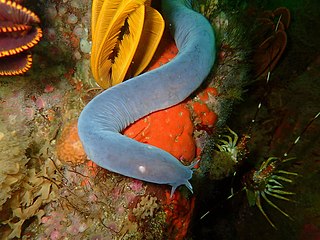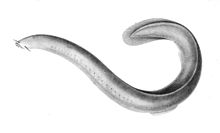
Hagfish, of the class Myxini and order Myxiniformes, are eel-shaped jawless fish. Hagfish are the only known living animals that have a skull but no vertebral column, although they do have rudimentary vertebrae. Hagfish are marine predators and scavengers who can defend themselves against other larger predators by releasing copious amounts of slime from mucous glands in their skin.

Eptatretus springeri, the Gulf hagfish, is a bathydemersal vertebrate which lives primarily in the northeastern Gulf of Mexico. It has been observed feeding at and around brine pools: areas of high salinity which resemble lakes on the ocean floor that do not mix with the surrounding water due to difference in density. The high salt content, approximately 200 ppt compared to 35 ppt for standard seawater, creates a buoyant surface which renders oceanic submersibles unable to descend into the pool. It is believed that the inside of the pools only supports microbial life, while the majority of macroscopic life, such as methane-utilizing mussels, exists on the edges. The Gulf hagfish feeds on the primary producers of these environments, as well as other predators.

The broadgilled hagfish or New Zealand hagfish, also known by its Māori language name tuere, is a hagfish found around New Zealand and the Chatham Islands as well as around the south and east coasts of Australia, at depths between 1 and 900 metres.

The Pacific hagfish is a species of hagfish. It lives in the mesopelagic to abyssal Pacific ocean, near the ocean floor. It is a jawless fish and has a body plan that resembles early paleozoic fish. They are able to excrete prodigious amounts of slime in self-defense.
Pterothrissus gissu, also known as the Japanese gissu, is a species of ray-finned fish in the family Albulidae. The Japanese gissu is a rare fish that is distributed in deep water off northwest Pacific Ocean. This fish is known to pass through a leptocephalus larval stage, but only metamorphosed specimens have been available. This species is the only member of its genus.

Eptatretus is a large genus of hagfish.

The inshore hagfish is a hagfish found in the Northwest Pacific, from the Sea of Japan and across eastern Japan to Taiwan. It has six pairs of gill pouches and gill apertures. These hagfish are found in the sublittoral zone. They live usually buried in the bottom mud and migrate into deeper water to spawn. The inshore hagfish is the only member of the Myxinidae family having a seasonal reproductive cycle.

Myxine is a genus of hagfish, from the Greek μυξῖνος. It is the type genus of the class Myxini.

The southern hagfish is a hagfish of the genus Myxine.
Eptatretus bischoffii is a common hagfish of the genus Eptatretus. Its maximum length is 55 centimetres (22 in). It lives in a demersal, non-migratory, marine habitat with its depth range between 8–50 m. It can survive in only temperate zones. These organisms are found in the South Pacific, mainly, Chile. It is harmless to humans.

Myxine glutinosa, known as the Atlantic hagfish in North America, and often simply as the hagfish in Europe, is a species of jawless fish of the genus Myxine.

Eptatretus deani, the black hagfish, is a species of hagfish.
Lipogenys gillii, the blackfin tapirfish, is a species of spiny eel in the family Notacanthidae, the only member of its genus. It is a benthic deep-sea fish occurring along the eastern coast of North America and in the southwestern Pacific near Australia at depths from 400 to 2,000 m.
Nemamyxine is a genus of hagfish.
Notomyxine tridentiger is a species of hagfish that occurs in the Atlantic Ocean off the southern coasts of South America. It is the only member of the genus Notomyxine. It can be found in the temperate waters of the Southeast Pacific and Southwest Atlantic, as well as the southern coasts of South America. It can reach a maximum length of 57 cm.
Rubicundus is a genus of hagfishes, the only member of the subfamily Rubicundinae. All species in it were formerly classified in Eptatretus. R. eos, R. lakeside, and R. rubicundus are known from single specimens caught in the Tasman Sea, Galápagos, and Taiwan, respectively. They are named after the distinctive red coloration that all species share.

Eptatretus hexatrema, the sixgill hagfish, or snotslang is a species of marine fish in the hagfish family of order Myxiniformes. It is native to the South Atlantic Ocean and southwestern Indian Ocean.

Eptatretus minor is a bathydemersal and non-migratory hagfish of the genus Eptatretus. It is found in the deep waters of the northern area of the Gulf of Mexico between Louisiana and Florida, at depths between 300 and 470 m. This hagfish is a relatively short and stout species, reaching a maximum length of nearly 40 cm. It is only known from a few specimens.

Nemoossis belloci, also known as the long-fin bonefish is a species of ray-finned fish in the family Albulidae endemic to the eastern Atlantic Ocean. This species is the only member of its genus.
Rubicundus lakeside, the Lakeside hagfish, is a species of jawless fish in the family Myxinidae.










